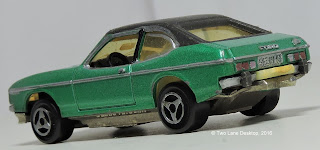Majorette Ford Capri and Lancia Montecarlo
Majorette is always looking for vehicles that are new and exciting for European countries for decades and in the 1970's they found two unique coupe models: one from Ford that would become a best-seller and an icon for Ford of Europe, while the Lancia coupe tries a new take on the Stratos design.
Ford Capri
The Capri was Ford of Europe's Mustang when it was introduced 1969. In fact, the designer of the car was also in part of the original Mustang development. The mechanicals are based on the Ford Cortina II, just like the Mustang was based on the Ford Falcon. The car has a long hood and short rear deck like the Mustang, but goes for an Euro look with flush headlights that integrate with the grille, a fastback coupe roofline, and typical rear-end design. The interior has a more Euro-centric design with well laid-out controls closer to the driver, 3-spoke steering wheel, and floor shifter. The powertrains lack any V8's like the Mustang, but offered V4 and V6 powertrains. The 2.0L V6 produces 125 horsepower to the rear wheels by a 4-speed manual transmission. The car was an initial success and over the next two generations does not change the style of the car much. Eventually the car would be replaced with the Ford Probe, but many enthusiasts want the original Capri to come back someday. In the U.S. the Capri was offered at Mercury dealers to avoid overshadowing the Mustang at Ford, but in 1979 the Capri was replaced with a Mustang-badged Capri model, and yes Ford foolishily offerd the name on a Mazda-based convertible in the early 1990's.
There are many colors offered by Majorette on the Capri, all of them clean with a separate plastic roof to emulate the vinyl-covered top design of the real cars. I have this mint green that I have not seen elsewhere since and it looks great. The front has flush headlights and signal lights that are part of the window trim and have a yellow tint; they connect to a center black grille with FORD letters and a lower bumper and license plate all part of the interior trim. The lower chin spoiler is part of the metal base. The side profile shows off the clean coupe styling with the front wheels dipping a bit on the beltline. The rear has tri-taillight design, FORD and Capri badges, and a rear bumper that is part of the black interior trim. The trailer hitch is also on the bumper though my tester has that long gone. The interior has a nice setup with a black dashboard and white seats that is nicely detailed from the 3-spoke steering wheel to the floor shifter and the front bucket seats. Surprisingly this Capri does not have any opening doors. Out of the many Capri's made in diecast out there I find this Majorette to be the best one in terms or details and proportions to the real car.
Lancia Montecarlo
After the success of the Stratos Lancia wanted to try again with a new version of the mid-engine rally car, this time called the Montecarlo. Introduced in 1975 the Pinninfarina-designed Montecarlo was not designed to replace the Stratos but instead the 124 and unlike the Stratos the Montecarlo never entered rally car racing and instead was more focused on the paved race tracks. The car has the wedge-shape look of the Stratos but was more inline with the style of the Lotus Esprit with the sharp-angled roofline, exposed C-pillars, and black plastic front bumper that conceals the headlights and grille. The interior was a proper Euro sports car with well-positioned controls and driver layout of the steering wheel and shifter. Early plans called for a V6, but emissions regulations instead placed the 2.0L DOHC I-4 that produced 120 horsepower through a 5-speed manual transmission and engine access was desinged with a side-opening rear trunk. Unfortunately, the Montecarlo was plagued with durability issues and regulations that affected the handling and output of the motor. After a few short runs the Montecarlo was never replaced.
Just like the Capri the Montecarlo was done in every color imagined by Majorette, so I have the yellow version with lower black trim that has the Montecarlo name. The front has the plastic bumper (part of the interior trim) that has the split grille, lower signal lights, and headlights that are part of the metal base. The hood has a dip in it with three vents near the cowl, while the sides show off that wedge look with open buttress at the rear and those wheels that are not so often used by Majorette back then. The rear has detailed taillights, a metal tab for the license plate area, black plastic lower bumper, and vents that poke out of the flat rear trunklid. It's a unique, if bizarre setup. There are no opening parts to show off the interior so details are there with bucket seats and dashboard layout, but not as impressive. The one opening part is on top as the sunroof is open at an angle; a nice touch, but being not supported and part of the plastic window piece the sunroof can be warped in various positions and after enough working it will eventually weaken and break off. Luckily mines still has the sunroof intact. A very nice set of European vehicles from Majorette that once again sets the brand apart from the rest.































Comments
Post a Comment